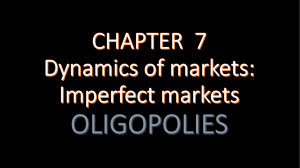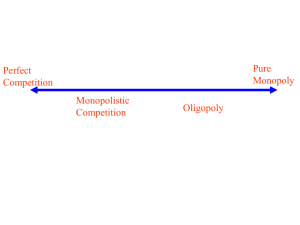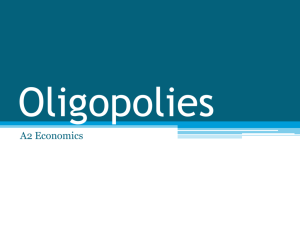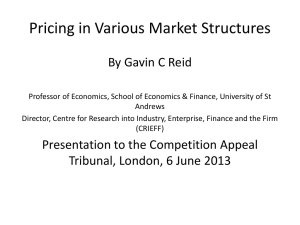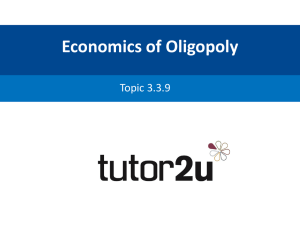oligopoly - The Toppers Way
advertisement
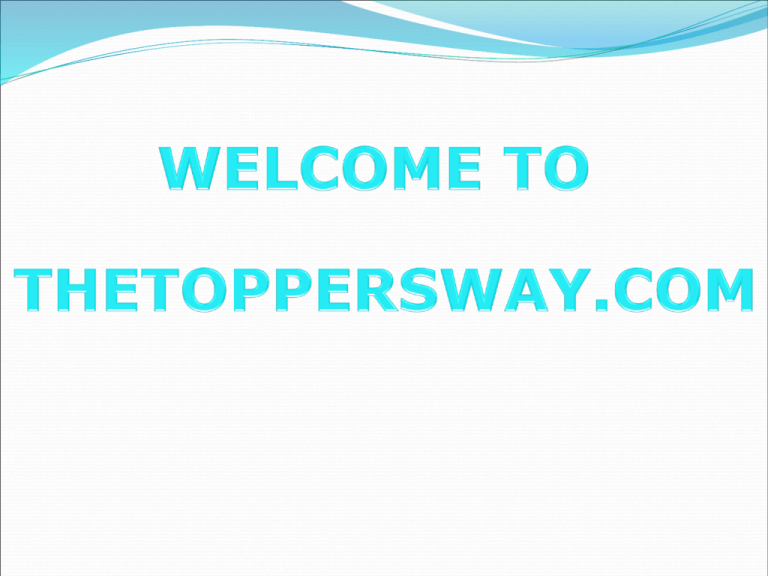
LECTURE 1 OBJECTIVES: Students should be able to: Identify and explain the characteristics of oligopoly. Imperfect Competition among the FEW OLIGOPOLY • Definition A market structure in which a few firms dominate the supply of an industry’s output and compete with each other for markets. Market Structure Oligopoly – Competition amongst the few Industry dominated by small number of large firms Many firms may make up the industry High barriers to entry Products could be highly differentiated – branding or homogenous Non–price competition Price stability within the market - kinked demand curve? Potential for collusion? Abnormal profits High` degree of interdependence between firms OLIGOPOLY Example Car industry Airline industry Cigarettes Cleaning products Electrical appliance Characteristics Implication of market domination Strong mutual interdependence among dominant firms in their price and output decisions. Characteristics Homogeneous or Differentiated Products Homogeneous product- pure oligopoly eg. Raw materials (oil, petrol, tin) Differentiated product- imperfect/ differentiated oligopoly eg. Cars, energy drinks. Characteristics Barriers to Entry Substantial barriers, similar to monopoly but not as restrictive eg. Petroleum industry Characteristics o Non-price competition Compete not through price but other methods (advertising, after-sales service, free gifts) NON-PRICE COMPETITION Practiced by oligopoly and monopolistic competition. Various forms: Competitive advertising – to reinforce product differentiation and harden brand loyalty. Promotional offers – eg. Household detergent, toothpaste, shampoo (buy 2 get 1 free), (25% extra at no extra cost). Extended guarantees/after sales service – esp. for consumer durables, by offering free spare parts, labour guarantee. Better credit facility Attractive gift wrappings Price Rigidity Prices are very inflexible Despite changes in underlying costs of production, firms are often observed to maintain prices at a constant level. Collusion Make agreement amongst themselves so as to restrict competition and maximise their own benefit. 1.PRICE DETERMINATION MODELS CARTELS PRICE LEADERSHIP 2. PRICE RIGIDITY MODELS KINKED DEMAND CURVE THEORY 1.PRICE DETERMINATION MODELS Collusive models Non Collusive models Collusive models assumes that there is an agreement between firms to fix prices or mutually divide the market. Firms work together and act like a profit maximizing monopolist. There are two types of collusion- 1. cartel 2. Price leadership Cartel is is an agreement between firms to fix prices or mutually divide the market. 1. PRICE DETERMINATION MODELS PRICE LEADERSHIP Usually there is a price leader in oligopoly collusion to determine price. Price leadership is of various types 1. Price leadership of dominant firm- this firm is producing large proportion of the total production in the industry and has great influence over the market. This firm estimates its own demand curve and fixes the price which maximizes its own profits. 2. Price leadership of barometric firm- this is an old experienced, largest and most respected firm assumes the role of a custodian who protects the interest of all. This firm fixes price which are the best from the point of view of all the firms in the industry. 3. Price leadership of Exploitative firm- this firm is very large and establishes its relationship by following aggressive price policies and thus compel the other firms in the industry to follow him in respect of prices. 2. PRICE RIGIDITY MODEL THE KINKED DEMAND CURVE THEORY (reaction model) Paul Sweezy 1930’s This model recognises that demand for a firm’s product is determined both by the market demand for a product as well as by rival firm’s behaviour £ Kinked demand for a firm under oligopoly Current price and quantity give one point on demand curve P1 O Q1 fig Q £ Stable price under conditions of a kinked demand curve MC2 MC1 P1 a D = AR b O Q Q1 MR KINKED DEMAND CURVE THEORY If the firm lowers its price below OP1, its rivals will follow. Its demand will expand along the relatively inelastic section of the demand curve below OP1 and total revenue will fall. KINKED DEMAND CURVE THEORY If the firm raises its price above OP1, none of its competitors will follow. Its demand for prices above OP1 will contract along the relatively elastic section of the demand curve and total revenue will fall. As a result of action and non-reaction to price changes, an oligopolist is faced with a kinked demand curve at OP1. Price rigidity is due to the kinked demand curve and the resulting discontinuity in the MR curve. Note: An oligopolistic firm faces a relatively more ELASTIC DDcurve at prices ABOVE a given market price and a relatively more INELASTIC DD curve at prices BELOW a given market price. Changing cost conditions Even though MC may be rising or falling, MC=MR in the portion of discontinuity will leave price and output unchanged at OP1 and OQ1. Ie. Changes in costs has no effect on profit maximising price and out put because the firm is still producing where MC=MR. ADVANTAGES OF OLIGOPOLY When firms collude – monopoly –supernormal profit – extra profit – extra capital – to fund R&D – benefit to consumer. Product differentiation – non-price competition– greater variety to consumers. Price stability/rigidity – helps in planning, reduce uncertainty. DISADVANTAGES OF OLIGOPOLY Collusive oligopoly if they agree upon output – no variety and improvement in quality – bad for consumers. o Acting like a monopoly Restrict output and charge a higher price Producer sovereignty Consumer sovereignty not respected Greater inequality in income (supernormal profits)
